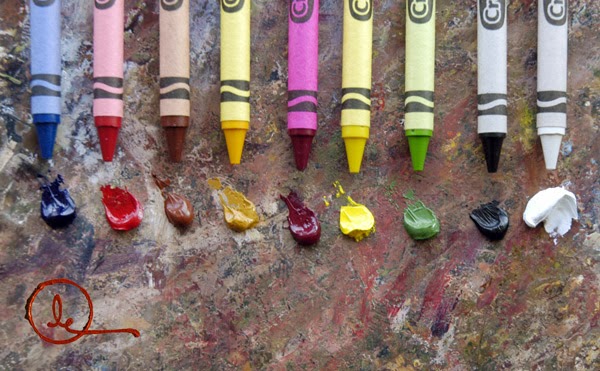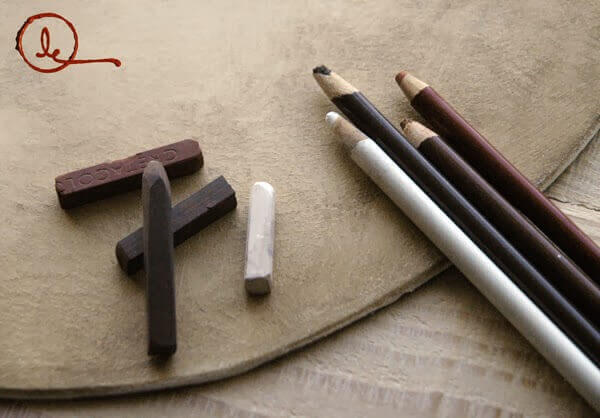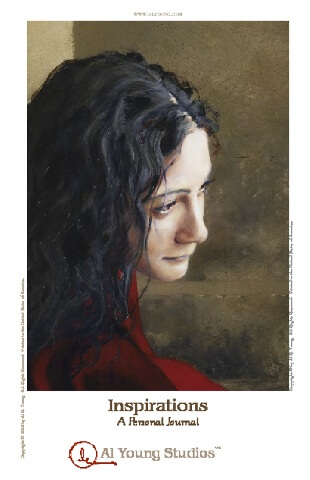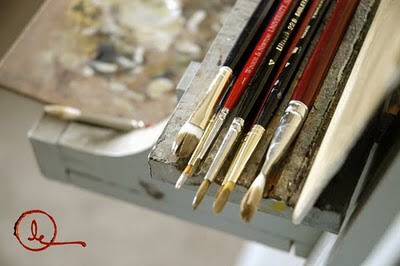Art lessons offered by Al Young Studios (overview)
By Elspeth C. Young
We are often asked if we give art lessons, and we are delighted to answer, "Yes! in the form of publications and online resources." For several years, we have been (and continue to be) hard at work designing art curriculum for all ages, interests, and abilities. Please visit the links below for ordering information as well as free online helps. |
| for children |
"A Beatrix Potter Painting Book" in The Storybook Home Journal , Vol. 11 No. 4 (Hearth article)
Inspired by Peter Rabbit's Painting Book (created by Beatrix Potter), Elspeth presents simple steps that help beginners play with paint while learning the rudiments of mixing colors—without having to capture form by translating three dimensions into two. Illustrations for this article include images by Beatrix Potter. Step-by-step instructions are illustrated with process photographs. Full color. Four pages.
"I'll Learn You" in The Storybook Home Journal , Vol. 13 No. 5 (Hearth article)
This lesson in color theory with crayons presents four projects to open a person's eyes to the world and uses of color. Two art projects help the beginner apply what they learn from artworks. Conceptually advanced enough to exercise even a professional artist, yet simple enough to finish before a brief attention span begins to wane. Step-by-step instructions are illustrated with process photographs. Full color. Four pages. Exercises include:
Hold a Crayon Like An Artist"A Notion Of Drawing" in The Storybook Home Journal , Vol. 14 No. 2 (Hearth article)
A Crayon Color Wheel
Spot The Colors
Animal Puzzle
In this second installment, Elspeth introduces the What Did You See Today? Game as well as six exercises:
The Crayon-Sketcher's PaletteStep-by-step instructions are illustrated with process photographs. Full color. Six pages.
A Line and Shadow Sampler
Spot the Shapes
Make a Blind-contour Coloring Book
Make a Ghost
A Value (Shaded) Drawing
"If She Doesn't Paint" in The Storybook Home Journal , Vol. 14 No. 3 (Hearth article)
The third installment in this series of art lessons for beginners and intermediate students focuses on how to look analytically at light or color, how to wield a brush for watercoloring, what a gradient is and how to make them, how to mix colors, and how to apply them. Illustrated. Full color. Five pages. Exercises include:
Light Lessons"The Most Splendid Drawings" in The Storybook Home Journal , Vol. 15 No. 1 (Hearth article)
Water Play
Brush Stroke Sampler
Brush Twirling
The Gradient Game
Mixing Paint
Flat Washes
Glazing
Dry Brushing
Master Study
This lesson applies to oil pastel, charcoal pencil, pastel pencil, hard pastel, compressed charcoal, natural charcoal, and conte. It includes not only tips and techniques, but warnings that parents should be aware of concerning health hazards lurking in a box of soft pastels or a stick of vine-charcoal. Full color. Four pages. Illustrated steps in creating a pastel study of one of Abbott Thayer's angel paintings. Exercises also include:
How to Hold a Stick"Engaged with Colored Pencils" in The Storybook Home Journal , Vol. 16 No. 3 (Hearth article)
Oil Pastel Blending
Mark Making with a Drawing Stick
Improvising a Drawing Board
Sketching a Mistletoe Sprig
An Example of How to Make a Pastel Painting
Tips for Avoiding an Awful Mess
Elspeth focuses on colored pencils, as a foundation for beginners and advanced studients alike. Topics include:
Getting outfitted"Drawing Suits Me Best" in The Storybook Home Journal , Vol. 16 No. 6 (Hearth article)
Holding a pencil properly
How to color
Shading
Blending
Drawing from life
Other projects such as a Decorative keepsake box and a Periwinkle motif
This article builds upon basic drawing techniques presented in "A Notion Of Drawing" in the Northanger Abbey issue of The Storybook Home Journal (Vol. 14 No. 2) and "A Real Feeling For Line" in The Red House issue of The Storybook Home Journal (Vol. 16 No. 4). Each of the exercises in the lesson can be studied in greater depth by beginners seeking to master the techniques described in all three lessons. Exercises include:
Getting Outfitted
Schoolroom Line Sampler
Miss Matilda's Weighted Line Rosette
Catherine Earnshaw's Free Sketch
Autumn Cross-Contour Drawing
Helen Graham Line Sampler
Wildfell Hall Tonal
 |
| for students |
"I Scarcely Can Wait tTo Try It" in The Storybook Home Journal , Vol. 7 No. 4 (Hearth article)
Recommendations for outfitting an inexpensive plein air studio. Illustrated. Full color. Two pages.
"Going To Copy" in The Storybook Home Journal , Vol. 13 No. 4 (Hearth article)
Tips and techniques (including instructions for creating an oil painting ground) for making oil painted copies of the Old Masters (see also Preparing a painting ground. Includes Elspeth's study of Fragonard, with lessons learned.
"If She Doesn't Paint" in The Storybook Home Journal , Vol. 14 No. 3 (Hearth article)
This installment in the series of art lessons for beginners and intermediate students focuses on how to look analytically at light or color, how to wield a brush for watercoloring, what a gradient is and how to make them, how to mix colors, and how to apply them. Illustrated. Full color. Five pages.
Light Lessons"The Most Splendid Drawings" in The Storybook Home Journal , Vol. 15 No. 1 (Hearth article)
Water Play
Brush Stroke Sampler
Brush Twirling
The Gradient Game
Mixing Paint
Flat Washes
Glazing
Dry Brushing
Master Study
This lesson applies to oil pastel, charcoal pencil, pastel pencil, hard pastel, compressed charcoal, natural charcoal, and conte. It includes not only tips and techniques, but warnings that artists should be aware of concerning health hazards lurking in a box of soft pastels or a stick of vine-charcoal. Full color. Four pages. Illustrated steps in creating a pastel study of one of Abbott Thayer's angel paintings. Exercises also include:
How to Hold a Stick"The Spot Where She Had Sketched" in The Storybook Home Journal , Vol. 15 No. 2 (Hearth article)
Oil Pastel Blending
Mark Making with a Drawing Stick
Improvising a Drawing Board
Sketching a Mistletoe Sprig
An Example of How to Make a Pastel Painting
Tips for Avoiding an Awful Mess
Plein air painting--sometimes sketching, sometimes just musing, and on other days painting from life on a wall-sized painting--is the focus of this art lesson. Gleaned from the trial and error of personal experience, Elspeth presents insights under these headings: Location, Plein Air Supplies, Perfect Plein Air Kit, The Monet Minute, Sighting.
"Several Beautiful Pictures" in The Storybook Home Journal , Vol. 15 No. 3 (Hearth article)
Perfect for beginners and professional alike, these painting and color exercises are building blocks by which a world of artistic journaling can be discovered at the end of a brush. In this second installment of Elspeth's plein air series, headings in the introduction include: Getting outfitted, A trusty beginner's palette (along with additional colors Elspeth uses). Color-mixing exercises in the article feature:
Watch the water-jar and palette play"Engaged with Colored Pencils" in The Storybook Home Journal , Vol. 16 No. 3 (Hearth article)
Pointillist swatches
Washes
Glazing
Elspeth focuses on colored pencils, as a foundation for beginners and advanced studients alike. Topics include:
Getting outfitted"A Real Feeling For Line" in The Storybook Home Journal , Vol. 16 No. 4 (Hearth article)
Holding a pencil properly
How to color
Shading
Blending
Drawing from life
Other projects such as a Decorative keepsake box and a Periwinkle motif
The art of pencil sketching and line drawing is a time-honored pursuit that is rewarding whether you are more concerned with capturing the moment and conceiving of a visual expression to pepper a personal journal or a letter with a bit of artistic flare or you want to produce renderings fit for a museum. Topics include:
Getting outfitted"As the Tints of Early Morning" in The Storybook Home Journal , Vol. 17 No. 2 (Hearth article)
Choosing Paper
Line Sampler
Value Life-Drawing
Elspeth presents a few of her own tips, secrets and techniques for finding safe passage through the narrows of painting with gouache. Headings include About Gouache, Safety and Clean-up, Paints, Brushes, Papers, and Palette. Exercises include:
Rainbow flower watercolor with gouache"Forget-Me-Not" in The Storybook Home Journal , Vol. 17 No. 3 (Hearth article)
Alla prima gouache
Layered gouache
Earth-tone portrait
Here are some child-proof (and adult-friendly) tips for capturing beautifully simple and simply beautiful forget-me-nots, gentians and sunny skies. Exercises include:
Mixing sunny-sky-blue"The Likeness To Himself" in The Storybook Home Journal , Vol. 17 No. 5 (Hearth article)
Creating Lottie's forget-me-not motif
Painting Lisa's alpine gentian
Portraiture tutorial, part 1. Elspeth has developed her own means for the tricky business of capturing anyone's likeness, based on the techniques and methods of Holbein's and Scrots' day—as timeless and reliable now as they were centuries ago—and she shares them in these pages. Exercises include:
Subject selection"Like A Picture Or A Dream" in The Storybook Home Journal , Vol. 17 No. 6 (Hearth article)
The sketch study
The cartoon
Portraiture tutorial, part 2. I continue this two-part look into the art of filling the sketch contours of a human face with the bold hues of painted portraiture in the historic style. Exercises include:
Selecting a support"Find the Extraordinary" in The Storybook Home Journal , Vol. 18 No. 1 (Hearth article)
Preparing the ground
The under-painting (or grisaille)
The under-painting under the under-painting
Portraiture tutorial, part 3. For those who may be new to working with live models, these tips come from the sunny Sundborn studio as well as our own. Exercises include:
Don't get discouraged"Exquisitely Painted" in The Storybook Home Journal , Vol. 18 No. 2 (Hearth article)
Look for epoch moments
Help the model feel comfortable
Optimize the model's time
Remember the pose
Working on the under-painting
Establish structural planes
Begin building contours of light-to-shadow
Begin indicating color planes
Portraiture tutorial, part 4. During this final phase of a portrait project, paint is added with varying degrees of oil, in varying thicknesses, and in varying degrees of translucence. Exercises include:
The over-painting"Of Noble Ancestry" in The Storybook Home Journal , Vol. 18 No. 5 (Hearth article)
Glaze deep mid-tones and shadows
Scumble mid-tones, mid-highlights and reflected light
Embellish brightest highlights
Finishing
Basics of egg tempera. Perfect for allergy sufferers, those with sensitive skin or sensitivity to odors, and especially those who paint at home, egg tempera in the following way is a wonderful alternative to oils or acrylics. Exercises include:
Painting in egg medium"Some Picture Painted" in The Storybook Home Journal , Vol. 19 No. 2 (Hearth article)
Studio materials
Painting technique
Clean up
Having painted Nigerians, Haitians, Ethiopians, African Americans, and a host of other races besides—Mestizo, Native American, Filipino, Oriental, Latino—the list goes on—there is, to my eye, no single magical key to the color scheme of the races. The only difference in the interracial skin-tone color wheel is where the highlight, mid-tone, and shadow dials express each individual. This article does not include exercises, but sets forth the basics of Elspeth's palette and techniques in meeting such needs.
 |
| Designed as a blank-book journal, this studio diary contains 53 commentaries, by the Artists of Al Young Studios, on such topics as their creative process, the creative environment of the Studios, technical approaches to their artwork, and inspiration from the work of other artists. |
 |
| for professional artists |
Project commentaries
Tips and techniques
Tools, supplies & studio operations
Inspiration & creativity
Tags: Vol. 7 No. 4, Vol. 11 No. 4, Vol. 13 No. 4, Vol. 13 No. 5, Vol. 14 No. 2, Vol. 14 No. 3, Vol. 15 No. 1, Vol. 15 No. 2, Vol. 15 No. 3, Vol. 16 No. 3, Vol. 16 No. 4, Vol. 16 No. 6, Vol. 17 No. 2, Vol. 17 No. 3, Vol. 17 No. 5, Vol. 17 No. 6, Vol. 18 No. 1, Inspirations (lined notebook, 2-pack), 2019, Art lessons, Overview
Browse articles by year: 2025 . 2024 . 2023 . 2022 . 2021 . 2020 . 2019 . 2018 . 2017 . 2016 . 2015 . 2014 . 2013 . 2012 . 2011 . 2010 . 2009 . 2008 . 2007 . 2006 . 2005 . 2004 . 2003 . 2002 . 2001 . 2000 . 1999 . 1998 . 1997 . 1996
Browse articles by topic: Art lessons . BenHaven Archives . Blank art diaries . Fine art photography . Framing . Illustration . Inspiration and creativity . Isles of Rune . Limited Editions Collection . My Fathers Captivity . News . Novellas . Oil paintings and prints . Operations announcements . Orders and shipping . Overview . Portfolios . The Papers of Seymore Wainscott . Project commentaries . Recipes by Nancy Young . Recommended reading . Recommended viewing . Temple artworks . The Storybook Home Journal . Tips and techniques . Tools supplies and operations
Browse articles by topic: Art lessons . BenHaven Archives . Blank art diaries . Fine art photography . Framing . Illustration . Inspiration and creativity . Isles of Rune . Limited Editions Collection . My Fathers Captivity . News . Novellas . Oil paintings and prints . Operations announcements . Orders and shipping . Overview . Portfolios . The Papers of Seymore Wainscott . Project commentaries . Recipes by Nancy Young . Recommended reading . Recommended viewing . Temple artworks . The Storybook Home Journal . Tips and techniques . Tools supplies and operations